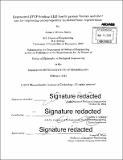| dc.contributor.advisor | Linda G. Griffith. | en_US |
| dc.contributor.author | Rivera Abreu, Jaime J. (Jaime Jose) | en_US |
| dc.contributor.other | Massachusetts Institute of Technology. Department of Biological Engineering. | en_US |
| dc.date.accessioned | 2015-07-31T19:10:19Z | |
| dc.date.available | 2015-07-31T19:10:19Z | |
| dc.date.copyright | 2015 | en_US |
| dc.date.issued | 2015 | en_US |
| dc.identifier.uri | http://hdl.handle.net/1721.1/97976 | |
| dc.description | Thesis: Ph. D., Massachusetts Institute of Technology, Department of Biological Engineering, 2015. | en_US |
| dc.description | Cataloged from PDF version of thesis. In title on title page, "[beta]" appear as lower case Greek letter. | en_US |
| dc.description | Includes bibliographical references (pages 107-125). | en_US |
| dc.description.abstract | Autologous bone marrow grafting has been shown to aid in the healing of bone defects since the 1950s. Transplantation of freshly-aspirated autologous bone marrow, together with a scaffold, is a promising clinical alternative to harvest and transplantation of autologous bone for treatment of large defects. However, survival and proliferation of the marrow-resident osteoprogenitors (CTPs) can be limited in large defects by the inflammatory microenvironment. Ligands that can improve CTP survival and other relevant upstream processes like colony formation and proliferation should advance bone healing. One such ligand is the Epidermal Growth Factor (EGF). EGF, when presented tethered (tEGF) on non-graftable synthetic polymer substrates, induced growth and colony formation of CTPs with additional cytoprotective effects not observed under soluble EGF stimulation. The objective of this thesis work was to test whether tEGF can be a viable alternative to enhance bone regeneration by tethering EGF onto a graftable, osteoconductive matrix, beta-tricalcium phosphate ([beta]TCP). Due to the lack functional groups for bioconjugation on the [beta]TCP surface, the tethering strategy involved the use of a high-affinity [beta]TCP binding peptide fused to the EGF domain. This broadly-applicable tethering strategy led to retention of tethered EGF for more than a week, while maintaining bioactivity in the bound state. Novel methods were designed in order to study the effects of EGF-tethered [beta]TCP scaffolds on marrow stromal cell proliferation and on osteoprogenitor colony formation from plated marrow. Results showed that tEGF can enhance both of these processes. This motivated a experiment designed to test the performance of EGF-tethered B-TCP scaffolds on a mid-sized, pre-clinical bone defect model (Canine Femoral Multi-Defect Model; CFMD). The CFMD model revealed that both control and EGF-tethered scaffolds promote bone formation to levels comparable to mineralized cancellous allograft, with the tEGF condition showing signs of advanced remodeling. However, due to a potential ceiling effect, a more compromised bone defect model will be needed to accurately assess differential graft performance. Altogether, this thesis demonstrates the capability of tEGF to influence important biological processes related to bone healing, which shows promise for its future use in bioactive graft formulations. | en_US |
| dc.description.statementofresponsibility | by Jaime J. Rivera Abreu. | en_US |
| dc.format.extent | 125 pages | en_US |
| dc.language.iso | eng | en_US |
| dc.publisher | Massachusetts Institute of Technology | en_US |
| dc.rights | MIT theses are protected by copyright. They may be viewed, downloaded, or printed from this source but further reproduction or distribution in any format is prohibited without written permission. | en_US |
| dc.rights.uri | http://dspace.mit.edu/handle/1721.1/7582 | en_US |
| dc.subject | Biological Engineering. | en_US |
| dc.title | Engineered [beta]TCP-binding HER-family protein fusions and their use for improving osteoprogenitor- mediated bone regeneration | en_US |
| dc.type | Thesis | en_US |
| dc.description.degree | Ph. D. | en_US |
| dc.contributor.department | Massachusetts Institute of Technology. Department of Biological Engineering | |
| dc.identifier.oclc | 914166707 | en_US |
